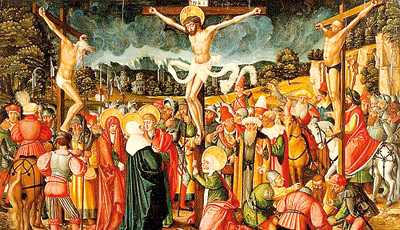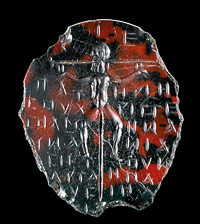Sunday Times 2
Was Jesus really nailed to the cross?

None of the Gospels in the New Testament mention whether Jesus was nailed or tied to the cross. However, the Gospel of John reports wounds in the risen Jesus's hands. It is this passage, perhaps, that has led to the overwhelming tradition that Jesus' hands and feet were nailed to the cross, rather than tied to it
Jesus’ crucifixion is one of the most familiar images from Christianity and Good Friday – approaching next week – marks this iconic event. But what was crucifixion, and why was Jesus killed that way? Meredith Warren, Lecturer in Biblical and Religious Studies at the University of Sheffield reveals that there are conflicting reports about whether Jesus was nailed or tied to the cross, and that the tales may be dictated by tradition in an article for The Conversation.
Some early Gospels, such as the Gospel of Thomas, don’t include the narrative of Jesus’ crucifixion, choosing instead to focus on his teaching.
But Jesus’ death by crucifixion is one of the things that all four canonical Gospels agree on.
Matthew, Mark, Luke, and John, all include the crucifixion event in their own slightly different ways.
None of the Gospels in the New Testament mention whether Jesus was nailed or tied to the cross. However, the Gospel of John reports wounds in the risen Jesus’s hands.
It is this passage, perhaps, that has led to the overwhelming tradition that Jesus’ hands and feet were nailed to the cross, rather than tied to it.
The Gospel of Peter, a non-canonical gospel from the first or second century CE, specifically describes in verse 21 how after Jesus had died, the nails were removed from his hands.
The Gospel of Peter also famously includes the cross itself as an active character in the Passion narrative.
In verses 41-42 the cross speaks, responding with its own voice to God: ‘And they were hearing a voice from the heavens saying, ‘Have you made proclamation to the fallen-asleep?’ And an obeisance was heard from the cross, ‘Yes.’
Tradition is clearly of paramount importance to this text.

Gemstones also provide some of our earliest depictions of the crucified Jesus. This second or third century piece of carved jasper depicts a man on a cross surrounded by 'magic' words
Over the past few years, several people have claimed to have found the actual nails with which Jesus was crucified.
Each time, biblical scholars and archaeologists have rightly pointed out the assumptions and misinterpretations of evidence behind these claims.
Curiously, this fixation on the nails persists, despite the fact that the earliest gospels make no mention of Jesus being nailed to the cross.
It isn’t surprising that Christians took a while to embrace the image of Christ on the cross, given that crucifixion was a humiliating way to die.
What is surprising is what the earliest image of the crucifixion turns out to be.
Rather than the devotional icons with which we are familiar – pictures that glorify Jesus’ death – this earliest image appears to be some late second-century graffiti mocking Christians.
Called the Alexamenos Graffito, the image shows a figure with the head of a donkey on a cross with the words: ‘Alexamenos worships his God.’
This was apparently a common accusation in antiquity, as Minucius Felix (Octavius 9.3; 28.7) and Tertullian (Apology 16.12) both attest.
Since the graffito was clearly not made by a Christian, this image suggests that non-Christians were familiar with some core elements of Christian belief as early as the second century.
Gemstones, some used for magical purposes, also provide some of our earliest depictions of the crucified Jesus.
This second or third century piece of carved jasper depicts a man on a cross surrounded by magic words.
Another very early image of the crucifixion is found carved into the face of a carnelian gemstone made into a ring.
Scholars think that the Constanza gemstone, as it is known, dates from the fourth century CE.
In this depiction, Jesus’ hands do not appear to be nailed to the cross, since they fall naturally, as if he is tied at the wrists.
Since the evidence from antiquity doesn’t provide a clear answer as to whether Jesus was nailed or tied to his cross, it’s tradition that dictates this common depiction.
Those who have seen the film The Passion of the Christ will recall how much time the director, Mel Gibson, devoted just to the act of nailing Jesus onto the cross – almost five whole minutes.
Given the relative silence on the act of crucifixion in the Gospels, this stands out as a graphic expansion.
One of the only films that does not assume that crucifixion involved nails is Monty Python’s Life of Brian, which shows multiple crucifixion victims, though not Jesus, tied to their crosses.
Eventually, Emperor Constantine put an end to crucifixion as a method of execution, not for ethical reasons, but out of respect for Jesus.
But in the end, it is the enduring image of the cross, and not the matter of whether nails or ropes were used, that most firmly evokes the death of Jesus in art and tradition.
© Daily Mail, London

